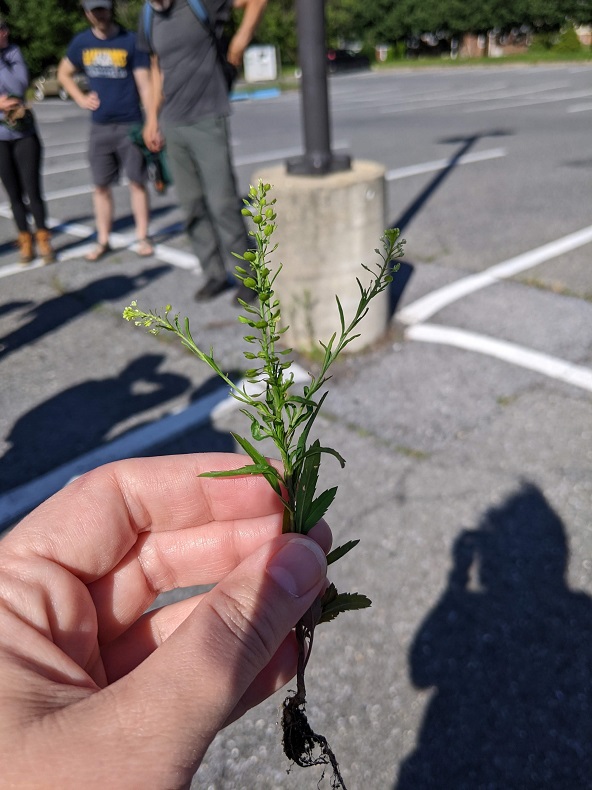
Did you know…that food…comes from plants?
A few weekends ago I went on an edible plant walk led by a local guy who knows his plants. That’s probably what his resume says. “Knows his plants.” Ten or so of us met on a sunny Sunday morning in a school parking lot to learn how to eat plants.
Ok, I’m aware that is how the whole food chain thing works. Plants make things; we eat the things. Apples come from plants. Lettuce is plants. Plants can even come with reminders that they’re part of the food web, like the caterpillars that hitchhike in broccoli sometimes, or the fresh garlic that comes attached to its above-ground parts.
But it feels different when you’re walking along in the suburbs, and the guy stops, and points out a wild garlic plant, and tells you can eat those teensy-weensy cloves growing in a sphere on top. Or when you pull it up and see the garlic clove right there, growing within a few feet of the athletic field like it was nothing. Or when he leans down in a patch of weeds and points out the wood sorrel, with its cute little heart-shaped leaves and its wee yellow flowers. As long as you’re confident that you can tell it apart from clover, which I am, not only can you eat the leaves, you can also eat the cute li’l seedpods and pretend that they are lemon candy.
So we walked, and we ate. Weedy little mustard in the parking lot – spicy! Plantain, an astoundingly common plant growing by the dumpsters – the tiniest leaves taste like mushrooms. Mmmm. Mulberries – delicious, and one of the few local plants I was already eating. Our guide shared a pro tip: If you’re going to harvest mulberries, go around tasting the trees until you find one you like, because they all taste different. Then spread out a tarp and shake the branches, and the ripe berries will drop off and come home with you.
Some of the plants he introduced us to need cooking. Some can make you quite sick if not handled properly – pokeweed, for example, a plant that I have admired before for its beautiful berries. (Fortunately, I had the good sense not to eat those berries.) One of the other women on the walk told me pokeweed was her introduction to foraging, and she had been extremely proud of herself for preparing the leaves safely and eating them, but didn’t plan to do it again. “But did you tell everyone that you’d done it?” I asked her. “Oh, I told everyone.”
We learned the difference between milkweed, which you can eat, and dogbane, which is poisonous. Both have milky sap, but one is very bad for you. He showed us poison ivy – not for eating, but on the principle that when you’re teaching newbies about plants, they should, at a minimum, go home knowing that one.
I brought home a produce bag stuffed with garlic mustard, an invasive plant; a container of mulberries; some wild garlic; and handful of lemon balm leaves. My garlic mustard pesto made a great pizza sauce. My wild garlic is just like garlic, but with annoyingly tiny cloves and I picked it myself. And the other night I drank my lemon balm tea.
I’ve only eaten a few plants out in the wild since then. Most of the places I walk are heavily used by dogs, and I don’t really want to grab a plantain and stick it in my mouth when I don’t know who’s peed there lately. But there’s a healthy patch of wood sorrel in a tall concrete planter a few blocks from here, and every time I walk by it I stop, pick out a sour-lemon seedpod, and relish my new knowledge, eating it in tiny bites.
This is, obviously, how animals work. Someone teaches us a plant is edible, we find it again, we eat it, hopefully we find enough of it to keep ourselves alive. If we’re of a particular species of bipedal ape, we take the edible plant and figure out how to domesticate it and sell it and breed it into tasteless versions of itself that can be shipped around the world in containers. So that’s the stage we’re at now. But it’s nice to know, even here in the near-suburbs, I do have the option of stopping, picking something, and feeding myself with it.
Photo: Helen Fields
Lettuce is plants! Love this and you Helen